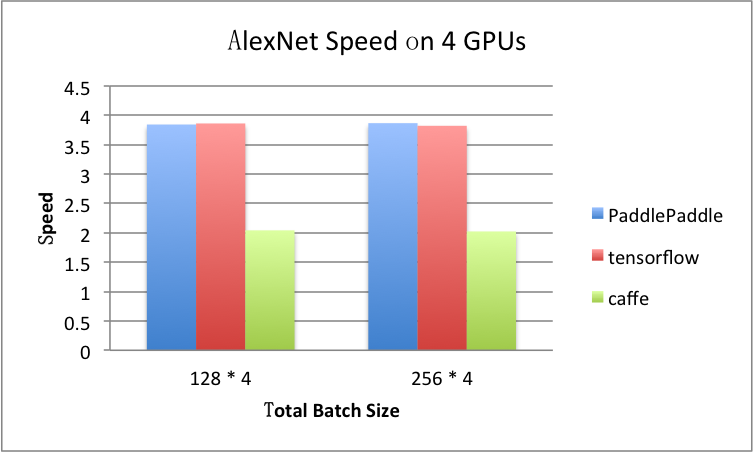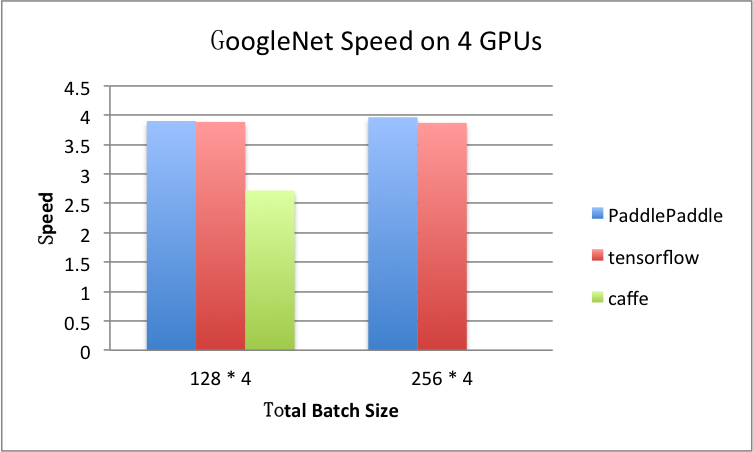# Benchmark
Machine:
- CPU: 12-core Intel(R) Xeon(R) CPU E5-2620 v2 @2.10GHz
- GPU: Tesla K40m
- cuDNN: v5.1
- system: Docker 1.12.1, all platforms are tested in docker environment.
Platforms:
- PaddlePaddle: paddledev/paddle:gpu-devel-v0.9.0a0
- Tensorflow: gcr.io/tensorflow/tensorflow:0.11.0rc0-gpu
- Caffe: kaixhin/cuda-caffe
Several convolutional neural networks and recurrent neural networks are used to test.
## Image
### Benchmark Model
AlexNet, GoogleNet and a small network used in Caffe.
- [AlexNet](https://github.com/BVLC/caffe/tree/master/models/bvlc_alexnet): but the group size is one.
- [GoogleNet](https://github.com/BVLC/caffe/tree/master/models/bvlc_googlenet): but remove loss1 and loss2 when testing benchmark.
- [SmallNet](https://github.com/BVLC/caffe/blob/master/examples/cifar10/cifar10\_quick\_train\_test.prototxt)
### Single-GPU
- AlexNet: input - 3 * 227 * 227, Time: ms/batch
| BatchSize | 64 | 128 | 256 | 512 |
|--------------|-----| -----| ------| -----|
| PaddlePaddle | 195 | 334 | 602 | 1629 |
| TensorFlow | 223 | 364 | 645 | 1235 |
| Caffe | 324 | 627 | 1232 | 2513 |
**Notation**
All platforms use cuDNN-v5.1. We see that caffe is slower in this experiment, because its workspace limit size of cuDNN-conv interface is 8 * 1024 * 1024, which is smaller in PaddlePaddle and TensorFlow. Note that Caffe will be faster if increasing the workspace limit size.
- GoogletNet: input - 3 * 224 * 224, Time: ms/batch
| BatchSize | 64 | 128 | 256 |
|--------------|-------| -------| --------|
| PaddlePaddle | 613 | 1149 | 2348 |
| TensorFlow | 644 | 1176 | 2219 |
| Caffe | 694 | 1364 | out of memory |
- SmallNet: input - 3 * 32 * 32, Time ms/batch
| BatchSize | 64 | 128 | 256 | 512 |
|--------------|--------| -------- | --------|---------|
| PaddlePaddle | 10.463 | 18.184 | 33.113 | 63.039 |
| TensorFlow | 9 | 15 | 28 | 59 |
| Caffe | 9.373 | 16.6606 | 31.4797 | 59.719 |
**Notation**
All the experiments in caffe use `caffe time` to execute, which does not include the time of parameter updating. While PaddlePaddle and TensorFlow contains this time. But, compared with the total time, the time of parameter updating is relatively little on single machine.
In Tensorflow, they implement algorithm searching method instead of using the algorithm searching interface in cuDNN.
### Multi-GPU: 4 GPUs
- AlexNet, ms / batch
| total-BatchSize | 128 * 4 | 256 * 4 |
|------------------|----------| -----------|
| PaddlePaddle | 347 | 622 |
| TensorFlow | 377 | 675 |
| Caffe | 1229 | 2435 |
For example, if `total-BatchSize = 128 * 4`, the speedup ratio is calculated by
```
time_at_1gpu_batch_128 * 4 / time_at_4gpu_total_batch_512
= (334 * 4)/347
= 3.85
```
 - GoogleNet, ms / batch
| total-BatchSize | 128 * 4 | 256 * 4 |
|-------------------|--------------| ----------- |
| PaddlePaddle | 1178 | 2367 |
| TensorFlow | 1210 | 2292 |
| Caffe | 2007 | out of memory |
- GoogleNet, ms / batch
| total-BatchSize | 128 * 4 | 256 * 4 |
|-------------------|--------------| ----------- |
| PaddlePaddle | 1178 | 2367 |
| TensorFlow | 1210 | 2292 |
| Caffe | 2007 | out of memory |
 ## RNN
We use lstm network for text classfication to test benchmark.
### Dataset
- [IMDB](http://www.iro.umontreal.ca/~lisa/deep/data/imdb.pkl)
- Sequence legth is 100. In fact, PaddlePaddle supports training with variable-length sequence, but TensorFlow needs to pad, we also pad sequence length to 100 in PaddlePaddle in order to compare.
- Dictionary size=30000
- Peephole connection is used in `lstmemory` by default in PaddlePaddle. It is also configured in TensorFlow.
### Single-GPU
#### LSTM in Text Classification
Testing `2 lstm layer + fc` network with different hidden size and batch size.
- Batch size = 64, ms / batch
| hidden_size | 256 | 512 | 1280 |
|--------------|-------| -------| --------|
| PaddlePaddle | 83 | 184 | 641 |
| TensorFlow | 175 | 280 | 818 |
- Batch size = 128, ms / batch
| hidden_size | 256 | 512 | 1280 |
|--------------|------- | -------| --------|
| PaddlePaddle | 110 | 261 | 1007 |
| TensorFlow | 181 | 361 | 1237 |
- Batch size = 256, ms / batch
| hidden_size | 256 | 512 | 1280 |
|--------------|-------| -------| --------|
| PaddlePaddle | 170 | 414 | 1655 |
| TensorFlow | 238 | 536 | 1905 |
## RNN
We use lstm network for text classfication to test benchmark.
### Dataset
- [IMDB](http://www.iro.umontreal.ca/~lisa/deep/data/imdb.pkl)
- Sequence legth is 100. In fact, PaddlePaddle supports training with variable-length sequence, but TensorFlow needs to pad, we also pad sequence length to 100 in PaddlePaddle in order to compare.
- Dictionary size=30000
- Peephole connection is used in `lstmemory` by default in PaddlePaddle. It is also configured in TensorFlow.
### Single-GPU
#### LSTM in Text Classification
Testing `2 lstm layer + fc` network with different hidden size and batch size.
- Batch size = 64, ms / batch
| hidden_size | 256 | 512 | 1280 |
|--------------|-------| -------| --------|
| PaddlePaddle | 83 | 184 | 641 |
| TensorFlow | 175 | 280 | 818 |
- Batch size = 128, ms / batch
| hidden_size | 256 | 512 | 1280 |
|--------------|------- | -------| --------|
| PaddlePaddle | 110 | 261 | 1007 |
| TensorFlow | 181 | 361 | 1237 |
- Batch size = 256, ms / batch
| hidden_size | 256 | 512 | 1280 |
|--------------|-------| -------| --------|
| PaddlePaddle | 170 | 414 | 1655 |
| TensorFlow | 238 | 536 | 1905 |
 #### Seq2Seq
The benchmark of sequence-to-sequence network will be added later.
### Multi GPU: 4 GPUs
#### LSTM in Text Classification
- hidden_size = 256, ms / batch
| batch_size | 256 | 512 |
|--------------| -------| --------|
| PaddlePaddle | 90 | 118 |
| TensorFlow | 226 | 118 |
- hidden_size = 512, ms / batch
| batch_size | 256 | 512 |
|--------------| -------| --------|
| PaddlePaddle | 189 | 268 |
| TensorFlow | 297 | 383 |
#### Seq2Seq
The benchmark of sequence-to-sequence network will be added later.
### Multi GPU: 4 GPUs
#### LSTM in Text Classification
- hidden_size = 256, ms / batch
| batch_size | 256 | 512 |
|--------------| -------| --------|
| PaddlePaddle | 90 | 118 |
| TensorFlow | 226 | 118 |
- hidden_size = 512, ms / batch
| batch_size | 256 | 512 |
|--------------| -------| --------|
| PaddlePaddle | 189 | 268 |
| TensorFlow | 297 | 383 |
 #### Seq2Seq
The benchmark of sequence-to-sequence network will be added later.
#### Seq2Seq
The benchmark of sequence-to-sequence network will be added later.
 - GoogleNet, ms / batch
| total-BatchSize | 128 * 4 | 256 * 4 |
|-------------------|--------------| ----------- |
| PaddlePaddle | 1178 | 2367 |
| TensorFlow | 1210 | 2292 |
| Caffe | 2007 | out of memory |
- GoogleNet, ms / batch
| total-BatchSize | 128 * 4 | 256 * 4 |
|-------------------|--------------| ----------- |
| PaddlePaddle | 1178 | 2367 |
| TensorFlow | 1210 | 2292 |
| Caffe | 2007 | out of memory |
 ## RNN
We use lstm network for text classfication to test benchmark.
### Dataset
- [IMDB](http://www.iro.umontreal.ca/~lisa/deep/data/imdb.pkl)
- Sequence legth is 100. In fact, PaddlePaddle supports training with variable-length sequence, but TensorFlow needs to pad, we also pad sequence length to 100 in PaddlePaddle in order to compare.
- Dictionary size=30000
- Peephole connection is used in `lstmemory` by default in PaddlePaddle. It is also configured in TensorFlow.
### Single-GPU
#### LSTM in Text Classification
Testing `2 lstm layer + fc` network with different hidden size and batch size.
- Batch size = 64, ms / batch
| hidden_size | 256 | 512 | 1280 |
|--------------|-------| -------| --------|
| PaddlePaddle | 83 | 184 | 641 |
| TensorFlow | 175 | 280 | 818 |
- Batch size = 128, ms / batch
| hidden_size | 256 | 512 | 1280 |
|--------------|------- | -------| --------|
| PaddlePaddle | 110 | 261 | 1007 |
| TensorFlow | 181 | 361 | 1237 |
- Batch size = 256, ms / batch
| hidden_size | 256 | 512 | 1280 |
|--------------|-------| -------| --------|
| PaddlePaddle | 170 | 414 | 1655 |
| TensorFlow | 238 | 536 | 1905 |
## RNN
We use lstm network for text classfication to test benchmark.
### Dataset
- [IMDB](http://www.iro.umontreal.ca/~lisa/deep/data/imdb.pkl)
- Sequence legth is 100. In fact, PaddlePaddle supports training with variable-length sequence, but TensorFlow needs to pad, we also pad sequence length to 100 in PaddlePaddle in order to compare.
- Dictionary size=30000
- Peephole connection is used in `lstmemory` by default in PaddlePaddle. It is also configured in TensorFlow.
### Single-GPU
#### LSTM in Text Classification
Testing `2 lstm layer + fc` network with different hidden size and batch size.
- Batch size = 64, ms / batch
| hidden_size | 256 | 512 | 1280 |
|--------------|-------| -------| --------|
| PaddlePaddle | 83 | 184 | 641 |
| TensorFlow | 175 | 280 | 818 |
- Batch size = 128, ms / batch
| hidden_size | 256 | 512 | 1280 |
|--------------|------- | -------| --------|
| PaddlePaddle | 110 | 261 | 1007 |
| TensorFlow | 181 | 361 | 1237 |
- Batch size = 256, ms / batch
| hidden_size | 256 | 512 | 1280 |
|--------------|-------| -------| --------|
| PaddlePaddle | 170 | 414 | 1655 |
| TensorFlow | 238 | 536 | 1905 |
 #### Seq2Seq
The benchmark of sequence-to-sequence network will be added later.
### Multi GPU: 4 GPUs
#### LSTM in Text Classification
- hidden_size = 256, ms / batch
| batch_size | 256 | 512 |
|--------------| -------| --------|
| PaddlePaddle | 90 | 118 |
| TensorFlow | 226 | 118 |
- hidden_size = 512, ms / batch
| batch_size | 256 | 512 |
|--------------| -------| --------|
| PaddlePaddle | 189 | 268 |
| TensorFlow | 297 | 383 |
#### Seq2Seq
The benchmark of sequence-to-sequence network will be added later.
### Multi GPU: 4 GPUs
#### LSTM in Text Classification
- hidden_size = 256, ms / batch
| batch_size | 256 | 512 |
|--------------| -------| --------|
| PaddlePaddle | 90 | 118 |
| TensorFlow | 226 | 118 |
- hidden_size = 512, ms / batch
| batch_size | 256 | 512 |
|--------------| -------| --------|
| PaddlePaddle | 189 | 268 |
| TensorFlow | 297 | 383 |
 #### Seq2Seq
The benchmark of sequence-to-sequence network will be added later.
#### Seq2Seq
The benchmark of sequence-to-sequence network will be added later.